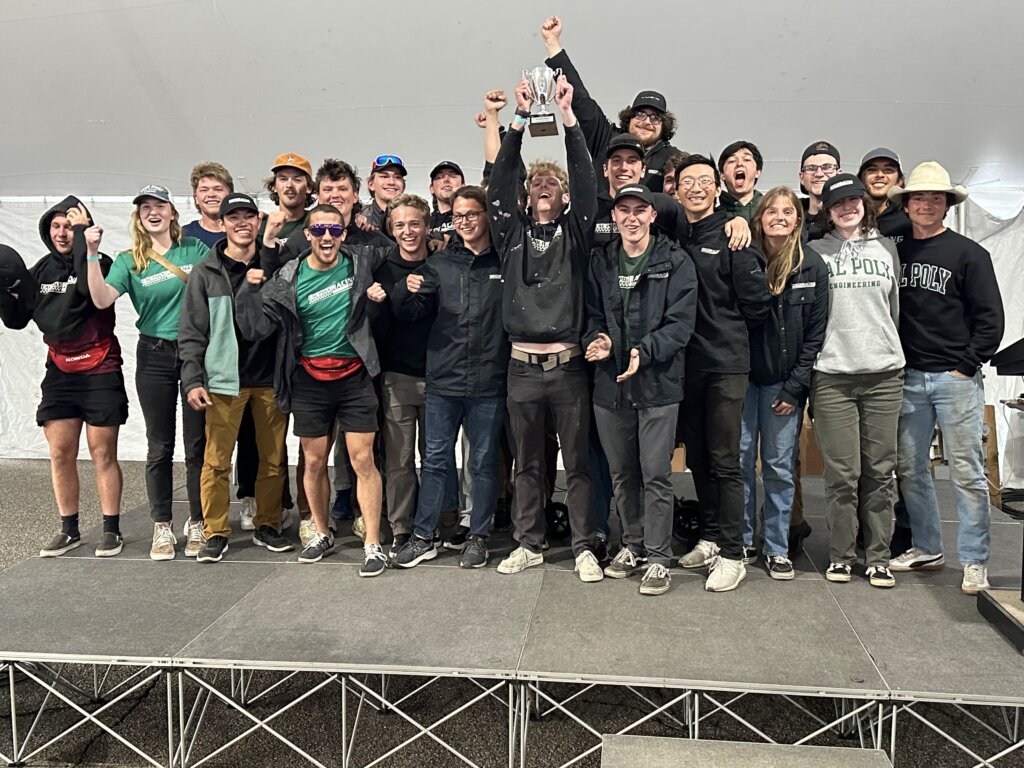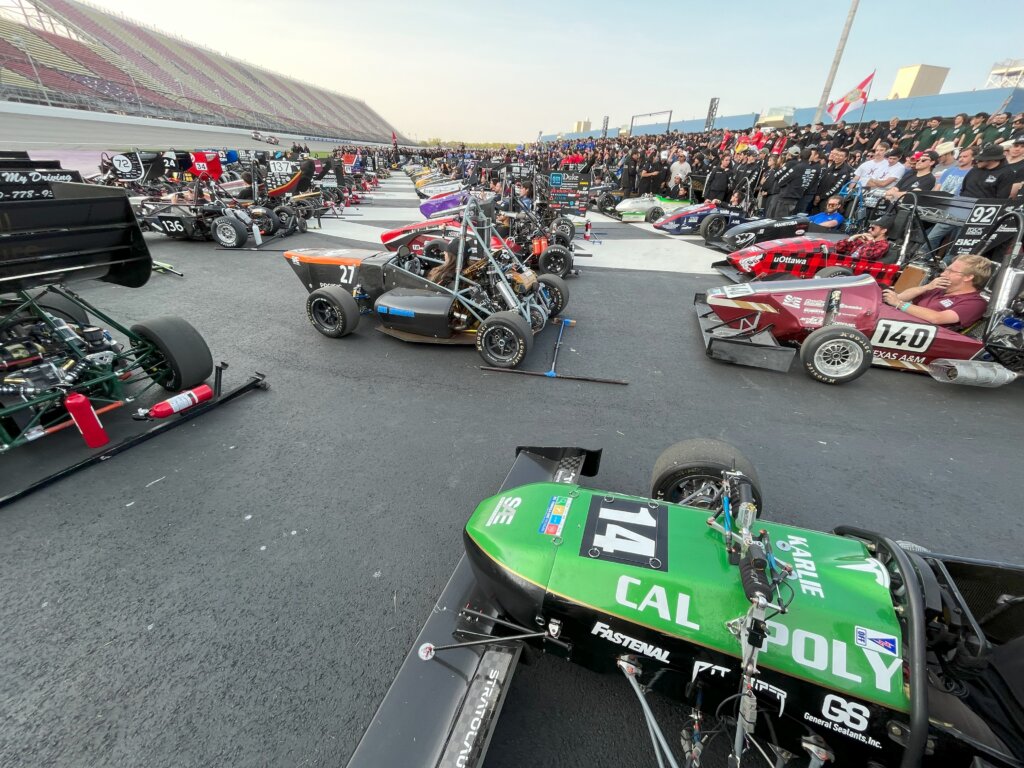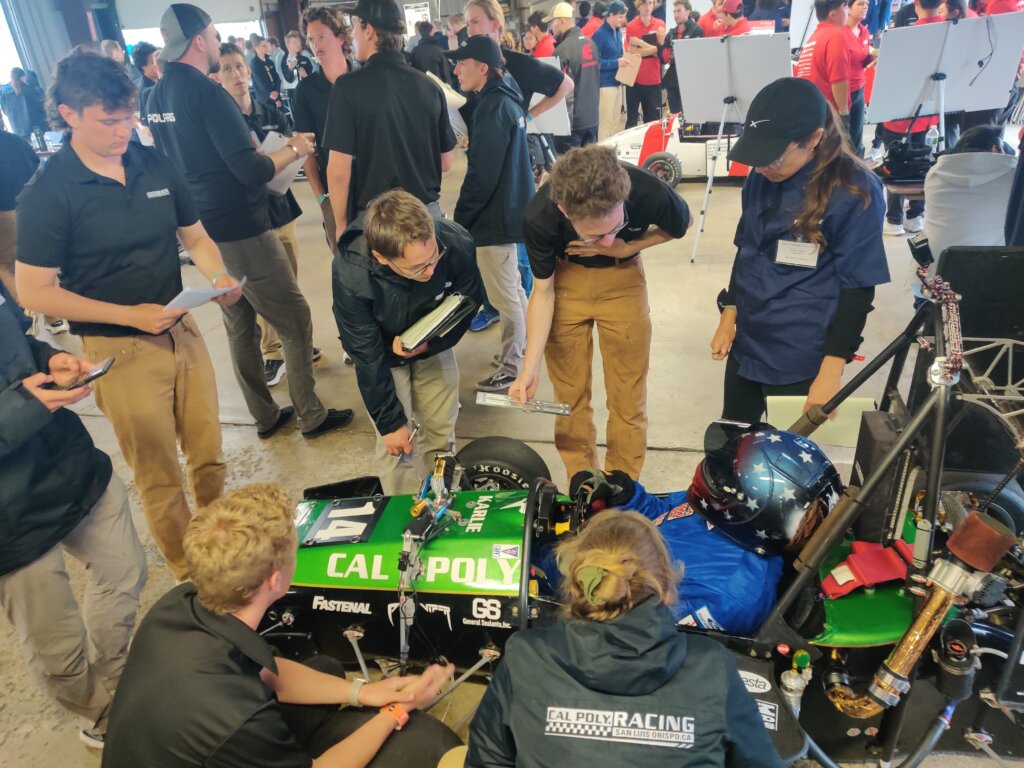Cal Poly Racing Formula SAE closed out one of the most successful seasons yet — achieving a record-high sixth place with their combustion car and 19th place with their electric vehicle — carrying on their legacy of excellence.
Both competitions were held at the Michigan International Speedway, with the last race of the season falling right in the middle of finals.
It wasn’t ideal timing, but team lead Elijah Schulz knew his crew members were up for the challenge.
“This year, we had to build our two cars with less time than ever — the competition was moved up a month and we started school later,” said Schulz, a third-year materials engineering major. “So, to achieve our best finish and win the most points with our combustion vehicle was huge for our club.”
On their return trip to Michigan, the team raced their Formula-style electric car against the best of the collegiate best around the nation and world, placing 19th overall and bringing back a second-place trophy in the cost event — all while passing their proctored finals.
“Our team is back to full force after COVID, and we are looking forward to even more success,” Schulz said as he detailed the club’s rebuilding and rise to glory.

Getting Up to Speed
Schulz’s first encounter with Cal Poly Racing was in fall 2020 during Week of Welcome, held virtually due to COVID.
When his WOW leader asked the freshmen to select a club meeting and attend over Zoom, Schulz picked Cal Poly Racing because the time slot lined up with his work schedule.
He admits he wasn’t a car enthusiast growing up in Phoenix, Arizona, but was drawn to the club’s cool factor: “When else do you have the opportunity to build race cars with a bunch of your friends?”
Cal Poly Racing is the largest student chapter of SAE International in California, with over 120 members from every engineering major and many others.
Each year, the Formula SAE team, consisting of 15 main subsystems, designs and manufactures two Formula-style vehicles — electric and combustion — to compete in international competitions.
In 2021, Schulz became brakes lead, then team lead in 2022.
“This year was especially hard because we only had four members last year who had been to a competition and only one person who had been through a design season, so it was a big push to get everyone back in the cycle,” he said.
Cal Poly’s Formula team is one of the few to simultaneously build a combustion and electric vehicle on the same platform.
“We usually start by saying we won’t redesign too much, but then we end up remaking everything,” Schulz said, with a laugh. “We do everything possible to make our cars lighter, because the lighter you are, the faster you are.”

Pedal to the Metal
CP23C and CP23E — affectionately called Karlie and Kiki — were born this spring.
Each year, the team names the vehicles based on letters of the alphabet after the tradition was sparked in 2013 when a sponsor sticker with the word “Annie” became that car’s moniker. Last year’s cars were called Jenny and Julie, followed by this year’s Karlie and Kiki.
Both cars feature a carbon fiber monocoque, new wheels and brand-new livery.
Testing follows manufacturing, with the team spending each weekend running their cars at Cal Poly’s H1 parking lot, then autocross tracks at the Santa Maria Public Airport and Santa Margarita Ranch.
Karlie and her 25 crew members were the first to travel to Michigan in mid-May, shining in early events with a fourth-place finish in design and finalist honor in business presentation. The team also won the coveted Vehicle Dynamics Award from Multimatic after demonstrating the best understanding of how their vehicle moves.
“We did really well in our design and static events, then the dynamic events went horribly,” Schulz said with a grimace, recounting their difficulties in acceleration, skidpad and autocross.
The team estimated they were in 17th place heading into the endurance event, where two drivers each complete five laps on one tank of gas. They could make up significant points but had to shake off the spectre of their earlier attempt.
“Last year, we only completed one lap because the restrictor exploded and we lost throttle control, but this year we ended up completing all the laps and finished P7,” said Schulz, noting their gas consumption was so high, they ended up using fuel left in the lines.

Going Full Throttle
Awards Day dawned, and the team members were in suspense as organizers announced the winners.
“We kept waiting and waiting to hear our name and were so happy when they finally called us for sixth place,” Schulz said. “We’ve never been higher in combustion as far as our records go.”
Another set of 30 crew members joined Kiki for FSAE Michigan Electric.
“The EV competition will be a lot harder as some of the really good teams only race with electric cars now,” he explained before the race. “But our electronic system is working better than ever.”
Kiki sports new Tesla high-density batteries and a livery that was designed by a student at Teach Elementary through the SAE LearnTwice program designed to inspire the next generation.
Their electric vehicle at 396 pounds is only slightly heavier than their combustion car at 377 pounds, a feat considering the weight of the batteries that allow for a higher speed than the combustion car’s top mark of 76 mph.
Schulz is proud of the team that keeps pushing the limits of what’s possible in car design and construction. He’s also grateful for the club that enabled him to chart his course and find his purpose.
This year, a sponsor gifted the club carbon fiber for their chassis — the same material used for the rockets Schulz could envision himself building after he wraps up classes this winter.
“I recently wrote the sponsor a letter and told her that without that carbon fiber, I wouldn’t have found something I’m passionate about; my career would be something totally different than aerospace.”
By Emily Slater



